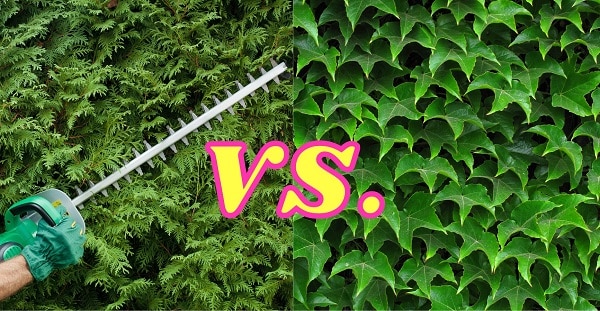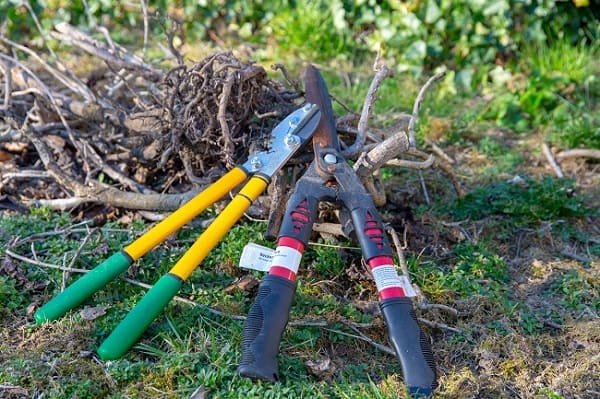
English Ivy adds a soft touch when growing on structures or when used in gardens. However, given its invasive nature, you need to trim it regularly to prevent it from going to an undesignated area and occupying your whole garden. Most homeowners have a problem figuring out which tool best works on ivy.
You can use a hedge trimmer on up to a 1/2 inch diameter ivy plant. Reciprocating long thin blades make it easier to put between the tree/fence and the ivy. However, if your ivy plant is overgrown and too thick, a hedge trimmer might not work by itself.
You may need to use other tools to cut ivy effectively. Read on to learn what you can use in combination with a hedge trimmer on ivy.
What are Hedge Trimmers Used For?
Hedge trimmers are gardening tools that you can use to prune, trim, and cut plants in the yard or garden. They are available in different designs and types. Although previous hedge trimmers relied on gas, you can now find electric-powered hedge trimmers.
Although these trimmers are used to trim back bushes and hedges, you can use them for different uses.
They can cut up to 1/2 an inch of ivy comfortably. Nevertheless, if you’re dealing with thick ivy branches and vines, a hedge trimmer won’t work. Also, cutting thick branches often dulls the blades quickly. You can combine a hedge trimmer with a hand saw to trim ivy correctly.
Below are some tools you can use to trim thick ivy branches.
Hand Pruners
Hand pruners are designed to cut thin pieces of plant smoothly. You can also use them to cut non-woody stems. There are two types of pruners-anvil pruners and bypass pruners.
Anvil pruners have a blade that slices the center of the fat lower base, while bypass pruners have a single-edged blade that cuts past a thick base as it closes.
Hand pruners or looper type pruners, a pry bar, and a fine-tooth handsaw can help you trim ivy effectively. Note that the process can be dirty and time-consuming as the ivy can come off as small pieces or as long strips.
Ensure that you have your gloves and mask on when trimming ivy as some people are sensitive to the oils in the plan. In case you can get to all the ivy, you can opt to cut a six-foot swath from the ground level going up to the trunk.
A basic hand pruner will help you cut through all the newly climbing ivy stems. Always use the deepest part of your pruners to cut off the growing vines. You can let the new growth above the cut die.
Ensure that the part you are cutting is up to four feet of the stem as this prevents the vines at the tree base from growing back up the tree. Sometimes English Ivy uses multiple rootlets to attach itself tightly. In this case, you may need to use a flat-bladed screwdriver before cutting the stem with hand pruners.
If you notice that the plant is opposite branching, cut directly across the stem above the node. Cutting straight across only works for alternate branching.
Remember that hand pruners are meant for small cuts and not removing large branches. If you’re cutting ivy branches that are larger than the diameter of your thumb, you might need to combine the pruners with a saw.
When dealing with ivy on the ground, you need to remove it before it climbs up a tree. Use the hand pruner to cut a line through the ivy along the ground, from the base of the tree to a distance of four to six feet away. Cut several lines radiating from the tree. Note that cutting the ivy into sectors allows for easy removal.
Hand Saw
If you’re dealing with ivy vines that are larger than an inch in diameter, you may need to use a hand saw. When dealing with thick, old vines, use a handsaw to carefully remove the ivy plant.
Make sure that you are careful when using the handsaw as you don’t want to make cuts on the tree. Ivy is invasive as it weakens trees and makes them susceptible to disease. Using a handsaw to cut through the bark could lead to more damage.
Pruning Saw
You can use a pruning saw for ivy vines that are too thick for a hedge trimmer or shears. To get started, get a pruning saw to cut through the vines at shoulder and ankle height. Nonetheless, this will depend on the vine’s diameter.
Be careful when using a pruning saw as you want to reduce damage to the bark. It’s safer to use the saw on the tree if you can pry the vine away from the tree to cut through the vine without the blade’s teeth getting too close to the tree. You can strip all the cut vines using a prying tool. Once done. Leave the ivy above the shoulder cut to dry off.
Reciprocating Saw
A reciprocating saw with a wood or demolition blade is another tool that you can use to cut through thick lines. It works perfectly when you’re handling large ivy from a number of trees. Although you can use a standard reciprocating saw blade to cut ivy branches, you’ll get better results when you combine it with a pruning blade.
Note that when using a reciprocating saw to print or trim ivy branches, always wear safety gear. That includes good footwear and eye protection. Also, keep a firm grip as a reciprocating saw tend to shake and bounce. The back and forth reciprocating motion can make it unsteady, that’s why you need to control the saw firmly each time.
When trimming ivy on the ground, but the bottom of the shoe on the material with the blade resting on the surface. Start the blade, and once it gets to full speed, tilt the blade onto the surfaces slowly. Continue tilting until the blade gets through the branches and make your cut. Wait for the blade to stop completely after releasing the trigger.
The advantage of a reciprocating blade is its lightweight and compact nature, that makes it easy to carry and move around. Moreover, it works quickly and gets the work done in no time with much flexibility and simplicity.
Pruning Shears

You can use pruning shears to cut back the stems of the ivy plant. Nevertheless, you may need to use pruning shears with a pruning saw to achieve the desired results. When using pruning shears, cut the ivy lines all the way around the tree at eye level. Some vines attach to the bark with aerial roots, but a pair of shears can help you get rid of them.
As you cut through the lines, peel the vines down from the bark. Lay the vines with the roots up as this will allow the roots to dry out and the vine to die.
Summary
You can use a hedge trimmer on ivy, but the vines need to be an inch thick to allow effective cutting. However, if you are handling large and thick vines, you may need to incorporate other tools like pruning shears and a pruning saw to get the work done. Pruning shears allow you to cut the vines around the base of the tree. Cut the vines at a height that gives you ample grip to pull the rest out.

